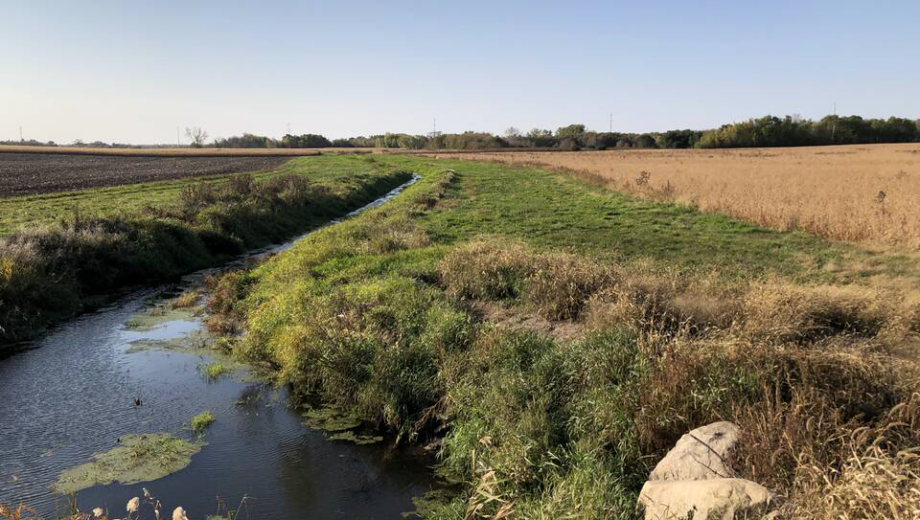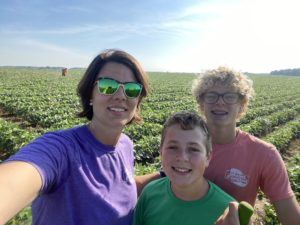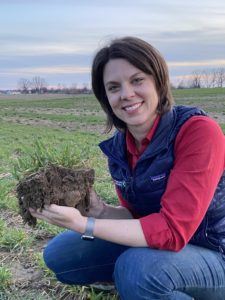
Upstream thinking for agricultural system change
What do teeth brushing, light switch timers, and grassed waterways have in common? They’re all preventative measures intended to solve problems before they begin—problems like cavities, arguments with your kids, and soil erosion. By incorporating these practices, thinking upstream of the root cause of the problem, we’re able to wisely conserve resources (money, time, and energy) that would be otherwise devoted to repairing the fallout to be used for worthier causes.
How might this upstream thinking apply to other elements of our world? That is the subject of Dan Heath’s book, Upstream: the quest to solve problems before they happen, which helps walk us through how to view problems with upstream systems thinking. Temporary fixes and band-aid remedies will not initiate lasting, large scale change, and—as Dan points out—macro change starts with micro efforts.
I work at the intersection of agriculture and the environment: a place where upstream thinking could change the world, literally. Research has shown that our farm fields, grazing lands, and pastures can sequester carbon and clean and store water for all of society’s benefit. Because these natural systems are still intact—though modified to raise row crops or feed sheep and cattle—the soil can help our air and water in ways that cities are unable. But to make these upstream changes, we must answer some key questions like: who should help initiate practices, markets, and infrastructure to increase the adoption of the carbon or water storage efforts? Who pays for these externalities, the side effects and impact of food production on our air quality and water quality and quantity?
As community members, we want clean air and water. As consumers, we want access to a variety of affordable food. The food supply chain is working to make all of those true at once, but the problem is that our current approach to this might be the equivalent of putting a bale of straw in rushing waters instead of repairing the gully and planting grasses: we may be seeking a short-term fix instead of a long-term solution. Heath outlines three challenges that prevent us from solving these systems problems, and it’s critical we face them, if we intend to back up our ambition with action.
- Problem Blindness – we believe negative outcomes are inevitable and there isn’t anything we can do about it.
- Lack of Ownership – there are too many small pieces, and no one owns the entire problem or, due to self-interest, someone else should fix it because it will cost me too much money.
- Tunneling – we put off the important in lieu of the urgent.
As a farmer, I understand the need to raise the most profitable crop possible while having a minimal environmental footprint and I understand the complexities that often arise as we try to meet these needs. Our goal is to pass our farm down to our kids and we see increasing the health and sustainability of our soil as a way to bring that goal to life. However, some of the on-farm practices that benefit society have such an extended return on investment (ROI) where we don’t expect a payoff for 10 years, and some even have a negative ROI—for us, those are the most daunting practices to embrace. Who can help support these practices that have a large societal gain, but little short-term gain to the farmer?
As an environmental economist and conservationist, paying for land management externalities like carbon sequestered and water stored in soil seems like a logical step for the public sector. Top of mind are reviewing real estate and income taxes and the U.S. Department of Agriculture’s (USDA) programs and policies, which all have a huge influence on our food system. State and federal governments could address these positive externalities through federal crop insurance discount programs, federal itemized tax deductions, or state real estate tax credits. Unfortunately, with so many different incentives and disincentives, practice adoption is scattered. The USDA’s intricate web of researchers, technical experts, and financial assistance programs has helped in advancing new practices. However, we can tell that these existing mechanisms for support aren’t realizing their full potential. In a report by the National Sustainable Agriculture Coalition, they found that just 1.4% of farmland received federal cost-share in 2018 to initiate these socially beneficial practices.

To use an example from the private sector, we know on one hand, food company procurement teams strive to pay as little as possible for farmers’ crops to keep grocery store prices low for consumers; and on the other, the same companies’ sustainability teams are often hard at work trying to lighten the burden on farmers of adopting practices that support clean air and water, through technical or financial support. This disconnect is not so much the key problem as it is a natural outcome of a system that fails to make good practices pay because of problem blindness, lack of ownership, and tunneling.
Thinking in terms of systems can be overwhelming—our challenges, opportunities, and solutions are interconnected, not to mention that what is an opportunity for one can be a challenge for another. On the international level, we can see efforts like the Paris Climate Agreement, signed and ratified by 190 countries, as an attempt to make good on the idea that despite the space between us we all have a shared interest in ensuring a future where people and nature can thrive. Crucially, many companies that play a role in our food system are making big commitments to reduce their greenhouse gas (GHG) emissions and setting ambitious water goals, and those that choose to operate globally are also subject to other countries’ standards. I’ve been impressed by the progress that companies like those in the Midwest Row Crop Collaborative (MRCC) have already made in a relatively short amount of time, and what I find so exciting about the role of companies is that some leaders are willing to consider their role beyond mitigating the impact of their operations—they’re thinking about the ways they can influence the system to produce better environmental outcomes for everyone.
Systems change does not come cheap or easy. We must be intentional and consistently support changes to the food system. Should only governments pay for change? No. Should only retail food companies pay for change? No. If we want the food supply system to change, we must engage the entire food system. The best way to find leverage for change is to get close to the problem and look for signs of early wins and continue to monitor progress. As the old adage goes, you measure what you care about, so make sure you are measuring the right things.
When it comes to transforming our food supply chain to reduce its water and air footprint, some groups are making headway to address the issue of ‘lack of ownership’ and measurement. Field to Market, a collaboration working across the agricultural value chain for continuous improvements in environmental outcomes, has made great headway by pulling together the organizations and companies who play a role in the sustainability of our food system. One area where they’ve been particularly successful is in helping to set metrics that measure the impact of food production, and their over 200 members offer a variety of viewpoints that help determine which are most meaningful.
However, practice adoption isn’t driven by metrics alone: food companies, farmer advisors, commodity buyers, and farmers base their decision on a constellation of data, culture, incentives, and disincentives. For example, procurement teams are rarely incentivized to buy ingredients grown sustainably but are motivated instead to purchase them at the lowest cost with the understanding that—unless specifically labeled—a commodity is a commodity and is no more valuable to the company when produced with more sustainable practices. While the traditional structure of sustainability teams typically focuses on projects, some companies are embracing the integration of sustainability teams into procurement, technology, finance, and other teams to understand what would make the biggest difference for the entire company.
Food companies are large with many moving parts, and they function within an enormous food system. To look at a single commodity like corn, there are more than 300,000 U.S. farmers who grow this crop, who buy inputs from 3-5 companies, and sell their commodity to 1-3 other companies. In a complex system where no one entity can take ownership, if we’re serious about climate change and clean, abundant water, we must not hide behind the goals we set or the projects we lead and let the system operate as usual. Despite the discomfort, we must push beyond the metrics because there are big, systemic questions we must answer:
- How can we create feedback loops for landowners, farmers, and input providers to manage land differently?
- How do we incentivize the procurement and product teams to support sustainably grown commodities?
- How do we quantify the cost of inaction?
- How do we know if the action taken is really succeeding?
Upstream has changed my perspective on where promise lies in a sustainable food system and has energized me to look at different parts of the system to create the change we need. Just as using bales of straw can slow the erosion in the field but makes no impact on the source of the problem, we need to embrace solutions upstream in our food and agricultural systems. For The Nature Conservancy and the other members of the Midwest Row Crop Collaborative, that orientation toward systems change is what unites us all. While none of us own the whole problem, we all must own part of the solution and do the important work.
 Carrie Vollmer-Sanders is the Agriculture Engagement Strategy Director for The Nature Conservancy, where her areas of focus include nutrient movement and conservation practice impacts in agricultural landscapes and the impact of farmer advisors on practice change. Carrie received the White House Champion of Change Award in 2014 for her leadership in developing the 4R Nutrient Stewardship Certification Program. She and her husband own and operate Grains and Greens, Inc. where they grow corn, soybeans, and wheat. Carrie holds a bachelor’s degree in Agriculture Education and a master’s degree in Agricultural Economics, both from Michigan State University.
Carrie Vollmer-Sanders is the Agriculture Engagement Strategy Director for The Nature Conservancy, where her areas of focus include nutrient movement and conservation practice impacts in agricultural landscapes and the impact of farmer advisors on practice change. Carrie received the White House Champion of Change Award in 2014 for her leadership in developing the 4R Nutrient Stewardship Certification Program. She and her husband own and operate Grains and Greens, Inc. where they grow corn, soybeans, and wheat. Carrie holds a bachelor’s degree in Agriculture Education and a master’s degree in Agricultural Economics, both from Michigan State University.